“Seattle churches wanting to build affordable housing face testing times”, Seattle Times
By Heidi Groover, Seattle Times business reporter, Sep. 29, 2024
The leaders of Saint Mark’s Cathedral on Capitol Hill have a vision: New neighbors living in the nearly century-old brick building the church owns just next to its cathedral. But landing one of Seattle’s overwhelmed affordable-housing developers proved challenging.
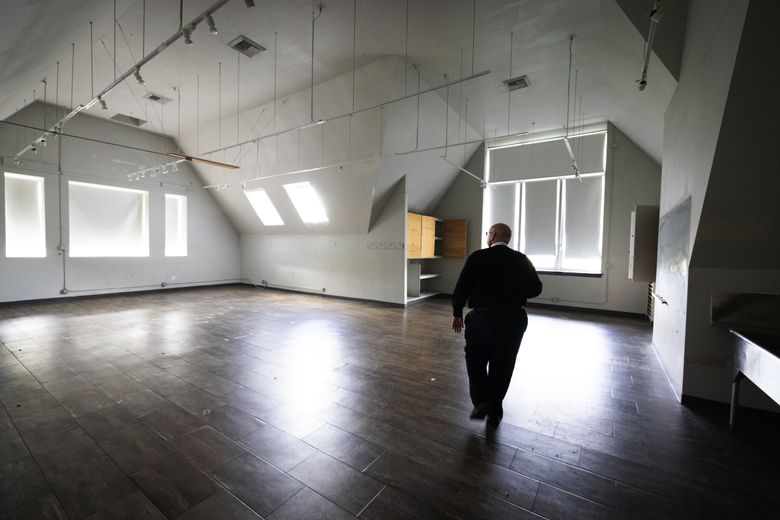
The Rev. Steven Thomason, of Saint Mark’s Episcopal Cathedral, walks through what had been an art classroom in the vast space of the cathedral campus’ Saint Nicholas building. The Capitol Hill congregation wants a partner to help usher in affordable housing here, but so far, Saint Mark’s hasn’t been able to find a developer to take on the project. (Ken Lambert / The Seattle Times)
In Lake City, a Mennonite church housed in an old movie theater found a developer to replace its current space with a seven-story affordable apartment tower, but funding hasn’t come through to make the project a reality.
Just off West Seattle’s California Avenue, a small United Church of Christ congregation also awaits funds to transform its property into condos and town homes, some for sale at below-market prices.
All over Seattle, churches have similar hopes and plans. They are eager to replace dated buildings or unused land with affordable homes for rent or for sale, seeing a connection between their faith and the city’s housing crisis. And, as church attendance dwindles, some congregations look to housing developments to buttress their budgets and keep their organizations alive.
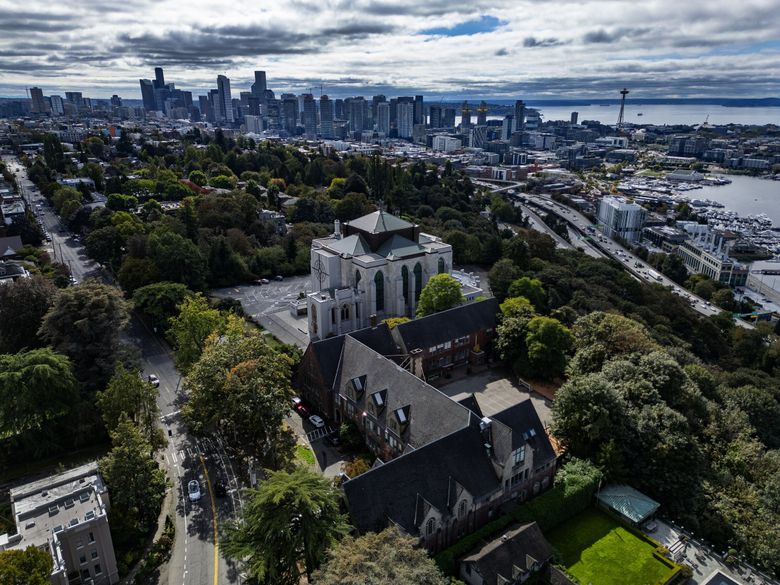
But they’re running into the stubborn challenges of Seattle’s real estate market: long planning timelines, nonprofit developers stretched thin, and, most of all, a far greater need for affordable housing than government funding available to build that housing. Many are learning the ins and outs of real estate development for the first time or tackling the delicate process of gaining trust from their congregations to hand over their land.
The dilemma underscores that even when churches are willing to offer their land for just a fraction of what the property would cost on the open market, building affordable housing is a hard-fought process that can take years as dozens of well-meaning projects compete for the same limited pool of funds.
“The snag isn’t the availability of property,” said John Hoerster, chair of the affordable-housing committee at Saint Mark’s.
Churches aren’t entirely new to addressing Seattle’s affordability crisis. Congregations have hosted homeless encampments and offered services to migrants and asylum-seekers. This spring, the Lutheran Church of the Good Shepherd in the Central District and the nonprofit Low Income Housing Institute finished a seven-story development for people who were previously homeless. Gethsemane Lutheran Church redeveloped its downtown landnearly a decade ago to add affordable housing. And the First A.M.E. Housing Association, affiliated with the city’s oldest Black church, operates several affordable-housing developments.
But as the housing shortage persists, some experts say lenders and local governments are growing more supportive of developments on church-owned land. And in one of the nation’s least religious cities, some churches are rethinking their role in the community.
Religious institutions of all faiths own about 1% of land in Seattle, with various uses ranging from churches to schools and cemeteries. Most of that land is in neighborhoods previously zoned for single-family homes or low-rise development, according to the city. The nonprofit The Nehemiah Initiative, which offers training and predevelopment financial help to churches planning for affordable housing, estimates that the city’s historically Black churches own about 75 acres of land that, if sold at market-rate prices, could be worth $200 million.
To transform their properties into affordable housing, churches typically donate, lease or sell land (often at a discount) to nonprofit developers with experience building affordable apartments for rent or homes for sale. Those developers tap into some combination of donations, private financing and federal, state or local dollars — such as the property tax-funded Seattle Housing Levy — to build and operate the housing. Discounts on land and public funding allow rents or sale prices below typical market rates. Developments sometimes include a new worship space for the church, though developers can’t use government housing dollars to build those spaces.
If successful, development on church-owned land could add hundreds of homes in Seattle neighborhoods where land costs are otherwise wildly expensive.
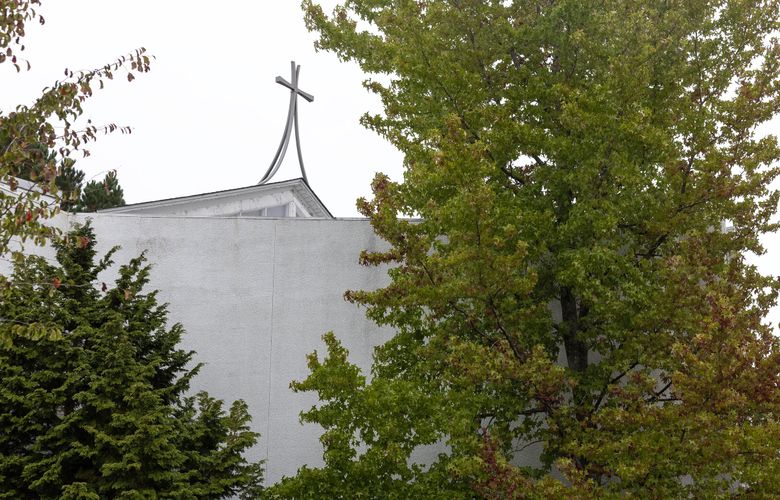
In Seattle and other nearby cities, more than 2,000 units of housing on church property are at some stage of planning or construction, said Jess Blanch, Pacific Northwest program director for Enterprise Community Partners, an organization that helps churches plan and finance housing development.
Local politicians have encouraged those developments. State lawmakers in 2019 required most cities to allow denser affordable-housing development on church land, and cities like Seattle have put those incentives on the books. Generally speaking, larger housing developments generate more rental or purchase revenue, making the project more financially feasible. Four developments have taken advantage of the new rules so far, three still under construction.
Even hundreds of units would be only a small contribution toward the more than 100,000 new homes needed across the city in the next two decades. Still, the developments would bring housing to lots that today feature underused buildings or empty parking lots, often in areas dominated by pricey single-family homes.
As he looks at the neighborhood surrounding his church in West Seattle, Admiral Church Rev. Andrew Conley-Holcom knows that for-profit developers are unlikely to offer low-cost housing there, where the median home sold for more than $900,000 last month.
“There’s really no likelihood that affordable housing is going to be built in North Admiral unless we do it,” Conley-Holcom said. “The math isn’t there for that.”
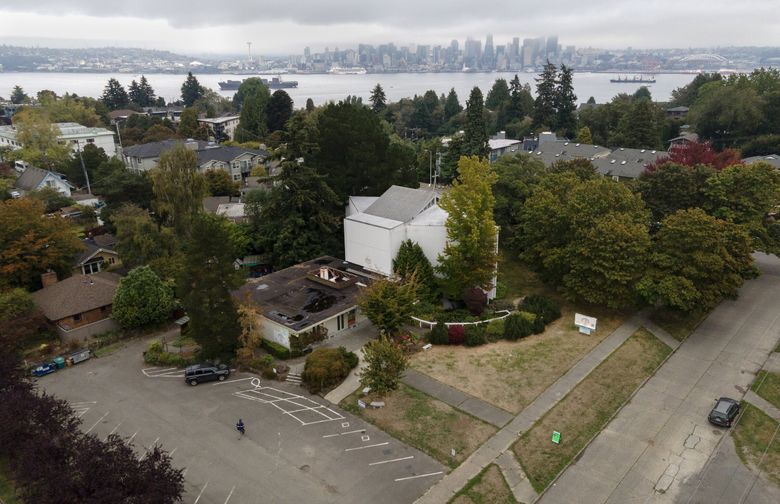
“Land rich and cash poor”
In West Seattle, Conley-Holcom’s congregation knew their property was worth “millions of dollars.” Meanwhile, their finances looked worse as their attendance shrunk.
At 37 members, the congregation is “probably the smallest it’s been” since the church’s 1899 founding, said church moderator Peggy Rich.
It’s a trend in religious institutions all over the country as fewer Americans attend nearly all kinds of religious services and a third of young people tell pollsters they have no religious preference.
“Going to church is not as popular as it used to be,” Rich said. “It’s the baby boom church now.”
Selling the land to a for-profit developer would have been the “easy solution,” seeding the church with an infusion of cash to retain staff and move to another building, Conley-Holcom said.
But the group voted to stay put. “We don’t want to just leave with a big bucket of money,” he said.
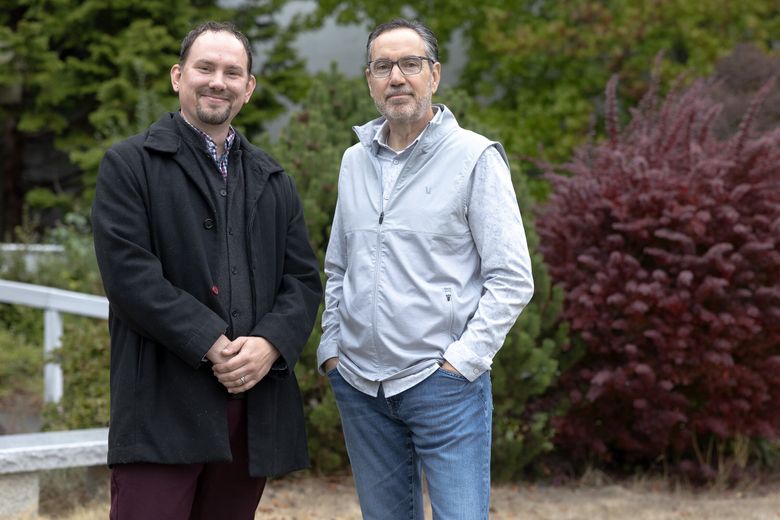
Instead, they partnered with Homestead Community Land Trust, agreeing to donate the land for a development of 21 town homes and condos for sale, a mix of market-rate and affordable homes expected to be complete in late 2026. In exchange, the development will include a new space for the church on the ground floor of the condo building. Affordable homes for sale will be targeted at those making 60%-70% of area median income, potential homebuyers often priced out of the for-profit market. Homestead is still seeking public funding to help make the $14.5 million project pencil out.
The development won’t generate ongoing revenue for the church but will free the congregation from the mounting maintenance costs of its aging building. “The facility itself at some point was going to bankrupt the congregation,” Conley-Holcom said.
For Conley-Holcom, the connection between housing and his Sunday teachings is obvious.
“The fact that housing isn’t affordable is a manifestation of the failure of capitalism to care for people,” he said, “and I believe that the Christian church is inherently an anti-capitalist institution that is designed to care for the least of these.”
Across town in the Central District, some of Seattle’s historically Black churches are also grappling with dwindling congregation numbers.
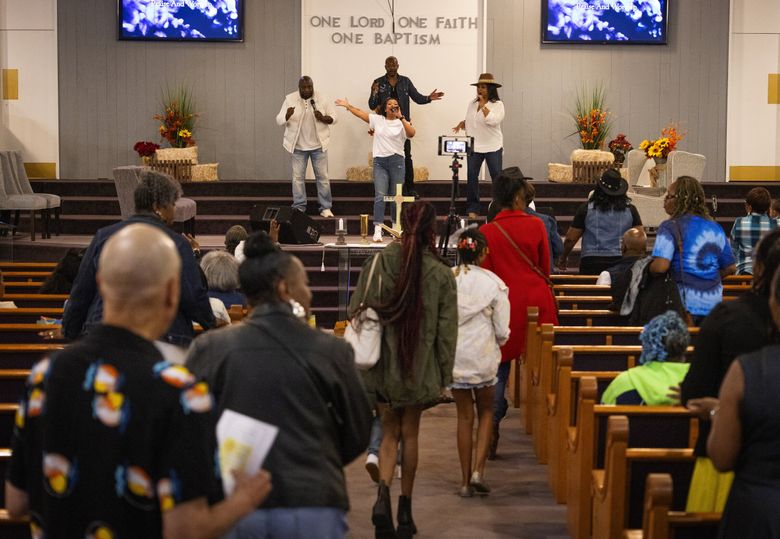
Under the soaring ceilings of Goodwill Missionary Baptist Church, Bishop Garry Tyson speaks to 100 or 150 people on a typical Sunday. The pews still vibrate with the energy of a dozen-member choir and a spirited congregation, but the attendance numbers are half of what they were before the pandemic, and far below the nearly 800 people who attended weekly in the 1970s and ‘80s. Some people are watching the livestream from home; others have simply been priced out of Seattle.
Tyson’s church and other historically Black congregations have seen attendance dip not only as part of a national trend but as gentrification has reshaped their neighborhoods and forced congregants to more affordable suburbs.
That has left his and other churches “land rich but cash poor,” Tyson said.
“It’s been the hardest season of my pastorate here in Seattle.”

Tyson watched other churches in the neighborhood cave to the intense pressures to sell. His church receives what feels like a constant stream of calls and letters from for-profit developers and real estate agents interested in the four plots the church owns. But he knows a fundamental truth about the price of land in Seattle: “Once you sell in the Central District, you can’t afford to buy back.”
So, the church instead looked for ways to generate some much-needed revenue while not letting go of the land altogether.
Hoping to help people build generational wealth, the church plans to lease an unpaved parking lot to Homestead for construction of 34 condos for sale at below-market prices. The church will continue services in the existing building nearby and will receive revenue from the land lease, homeowners association dues and leasing out a parking garage below the new development, Tyson said. Funding needed to build the condos is still to come, but Homestead could finish construction as early as 2027.
Tyson hopes the homes could be affordable enough to allow some of the church’s congregants to move back to the neighborhood. He said he saved for nearly 20 years to afford homeownership and still couldn’t afford to buy in King County. Instead, he bought in Pierce County.
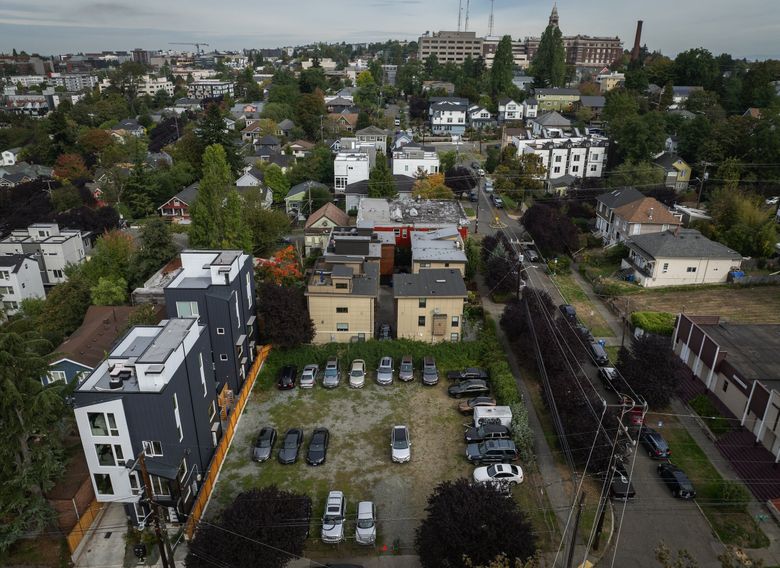
Churches across the Central District and in South Seattle amassed properties decades ago when the city’s Black community was larger and the houses of worship had funds to buy properties, said Donald King, CEO of the nonprofit The Nehemiah Initiative.
But property alone is not enough. Churches often lack the money and technical expertise to take on property development, areas where Nehemiah tries to offer help, King said.
That’s a common hurdle for religious groups across the country, said Enterprise Community Partners Vice President David Bowers. Bowers’ own seminary training covered the Old Testament, New Testament and a class where “they literally taught us how to counsel people who are dying,” he said.
“What I didn’t get in seminary was a class on how to run a pro forma or how to negotiate a land deal.”
Black pastors can face a particularly delicate discussion with their congregations about giving up church land. A long history of discrimination means Black congregations can eye partnerships with white-led developers and government agencies with suspicion, said the Rev. Dr. James Broughton, senior pastor at Damascus International Fellowship, whose church is studying the possibility of building a mix of market-rate and affordable housing on their Columbia City property.
After a history of slavery and rampant housing discrimination, “it was difficult to trust the government to not steal the land or lose the building,” Broughton said.
“You’re trying to convince people who know our history in this country that that’s not the case.”
Plans on hold
Other churches are hanging on financially, or even growing, seeing housing as an opportunity to make a dent in the city’s dire housing shortage. But they’re encountering other hurdles.
On Capitol Hill, leaders of Saint Mark’s Episcopal Cathedral hope to transform a building just north of their cathedral, currently leased to a nonprofit school, into more than 100 new affordable apartments. Cathedral leaders are eyeing ways to keep the landmarked Saint Nicholas building’s historic facade while renovating the rest of the building, which is already in need of costly repairs.
Saint Mark’s is “growing and financially sound” and building affordable housing next door is an effort to “be good stewards of this property,” said Rev. Steven Thomason.
Cathedral leaders find it difficult “to justify that the only people [who] could live here can spend $1 million or $2 million for a home or a condo in a building like this,” Thomason said on an early fall afternoon, standing in a sun-dappled Sunday school classroom in the Saint Nicholas building. “That doesn’t feel right to us.”
![Cathedral leaders find it difficult “to justify that the only people [who] could live here can spend $1 million or $2 million for a home or a condo in a building like this,” the Rev. Steven Thomason said of Saint Mark’s adjacent building. “That doesn’t feel right to us.” (Ken Lambert / The Seattle Times)](https://images.seattletimes.com/wp-content/uploads/2024/09/09242024_2-st-marks_121005.jpg?d=780x501)
Affordable-housing developers expressed interest in the site but described a “perfect storm” of market conditions, competition for affordable-housing dollars and other factors preventing them from taking on the project now, Thomason said.
ADVERTISING
Many nonprofit developers already have a number of projects in their pipelines or are struggling financially as they grapple with the same factors slowing the rest of the construction market: high interest rates and rising costs. Some nonprofits say they are also facing rising levels of unpaid rent from low-income tenants in the wake of the pandemic, making it harder to cover costs.
Citing all of those factors, nonprofits have looked for more city funding for projects already underway, reducing funds for new projects. Meanwhile, fees the city charges on for-profit development — a key source of money to build affordable housing — have declined as the real estate market slowed.
Those factors are all trickling down to potential new affordable-housing projects.
Seattle Mennonite Church in Lake City bought its properties using a donation in the 1990s, without a clear future plan for their use. The church wanted to build on its existing work supporting homelessness services and hosting an organized tent encampment.
“We don’t have to do it. We want to do it,” said Lee Murray, a member of the church team leading the housing project.
They’ve made some progress. The church and the nonprofit developer Community Roots Housing have detailed plans for 171 units of affordable rental housing, including hard-to-find two- and three-bedroom apartments, plus ground-floor space for the church and small businesses or nonprofits.
The church will sell the land for just under $8 million, less than market rate and about $1 million less than it appraised for — key to making the $108 million project pencil out.
But the project needs a mix of government funding, affordable-housing tax credits and private debt and, as public funds are stretched thin, has not been selected for public funding.
This month, they applied for funding a third time.